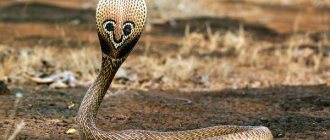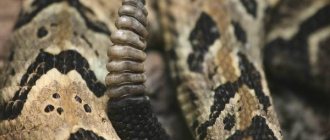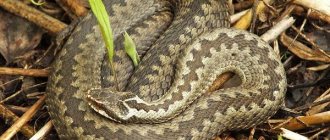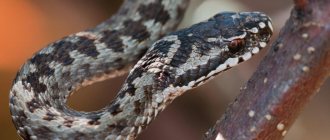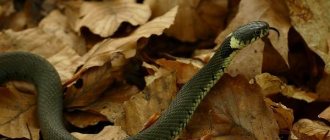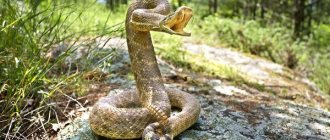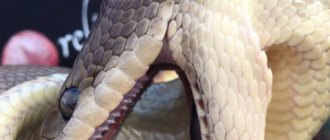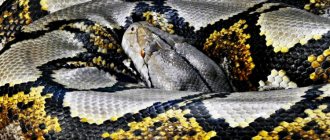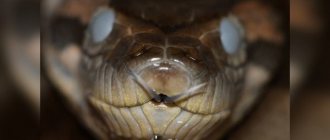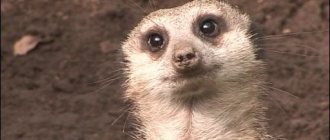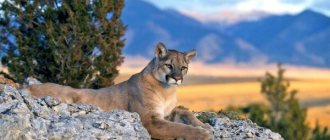- Habitats
The cobra, also known as the spectacled snake, is very popular in India, where since ancient times such a sight as a snake charmer in the market or just on the street has been quite common. An Indian fakir plays the pipe in front of a jug, from which rises a dangerous and poisonous cobra snake, a sight not for the faint-hearted Europeans (but quite familiar to Indians). The cobra is revered by some Hindus as a sacred snake, and in Malaysia there is even a special snake temple, where many cobras and other poisonous snakes live, which the temple servants feed with milk and care for them, while the grateful snakes do not bite anyone for this.
Description, structure, characteristics
It should be noted that the very name of this snake, “cobra,” is purely European; it was invented by the Portuguese, who first sailed to India in the 14th century on the ship of the great navigator Vasco de Gama. When they saw this unusual snake, they named it “Cobra de Capelo”, which means “snake in a hat” in Portuguese. The British, French and other European travelers and merchants, once in India, began, following the example of the Portuguese, to call all snakes with a “hood” cobras. In fact, there are many different types of hooded snakes (aka spectacled snakes, aka cobras), most of them, according to zoological classification, belong to the genus “true cobras.”
The size and length of a cobra depends on its age; the older it is, the longer it is. It is interesting that cobras generally grow throughout their lives, and the older they get, the more they increase in size. Also, the length of these snakes depends on the species, so the smallest South African shield cobra has 0.4-0.7 m in length, while the largest cobra in the world, the king cobra, reaches 5.85 meters in length with a weight of 12 kg.
Perhaps the most significant difference between cobras and other snakes is the presence of a characteristic “hood”, which, however, opens only when the snake is in an excited state. In a calm state, the “hood” of cobras is hidden and they cannot be distinguished from other snakes.
The cobra's hood opens thanks to the elastic muscles of eight pairs of ribs; with its help, snakes scare away potential enemies (including people).
The colors of a cobra depend on its habitat and species; coloring helps them to mimic (adapt) to the surrounding space, to merge as much as possible with the environment. Thus, desert cobras have a characteristic sandy-yellow color, and cobras living in the tropical forest are green.
Often cobras have light circles on the dorsal side of the upper body. Less pronounced transverse dark stripes are also another distinctive feature of the cobra.
The cobra's head is rounded at the front, but on top it is completely flat and covered with scutes. In the complete absence of the neck part of the snake, the head smoothly passes into the body.
Cobra scales are smooth. The ventral side of the snake is covered with expanded light scutes.
The cobra's eyes are small, non-blinking and dark in color; they are covered with a thin transparent film formed when the eyelids grow together. On the one hand, this film protects the snake’s eyes from dust, but on the other hand, because of it, cobras’ vision is not very clear. By the way, the cobra's eye film comes off along with its skin during molting. Cobras molt 4 to 6 times a year.
Poor vision is more than compensated by an excellent sense of smell. The cobra's nostrils are located on the sides of the front of the head. Cobras also have a very important organ - a chemical analyzer (known as Jacobson's organ), which is located in the form of two holes on the upper palate of the snake. This analyzer works in combination with the long and forked tongue of the cobra. By sticking out its tongue and testing surrounding objects with it, the cobra receives information about the chemical composition of the entire surrounding space, and with the help of smell it can at a distance detect traces of potential prey, a mating partner, and water supplies.
Cobras, like other snakes, are deaf in our understanding of the word, they do not have external ears, therefore, for example, a cobra simply will not hear a person’s screams or music. But they have a developed inner ear, capable of detecting even barely noticeable vibrations in the soil. That is, the cobra will not react in any way to a person’s screams, but will perfectly feel his stomping.
Stop, stop, if cobras are deaf, then how do Indian fakirs manage to conjure these snakes by playing the pipe, because they cannot hear music at all! In fact, playing the pipe is just a trick of the fakirs to divert attention, playing for the public; in reality, the cobra reacts not to playing the pipe, but to the special vibration that the fakir creates, imperceptibly tapping his foot on the ground in a special way. Also, the cobra is trained in advance by a fakir pipe, or rather by blows from this very pipe, and it (like Pavlov’s dog) has already developed a conditioned reflex - when the pipe appears, it should rise from the pot and expand its “hood”. And also, cobras participating in street performances often have the poison removed from their teeth, so that the fakir-caster is in no danger.
But let's return to the cobras themselves; the main weapon of these snakes is their sharp, poisonous tubular teeth. These teeth are located in the front part of the upper jaw and sit motionless in it. The poison flows inside the tooth through a special poison-conducting channel. Because of this structure of cobra teeth, their bite is poisonous and deadly (including for humans).
Cobras are very agile snakes; they are able to climb trees and swim in water. The average speed of a cobra is 6 km per hour. Cobras living in the desert are active during the day, but those snakes that live in tropical forests, on the contrary, are nocturnal.
Features of character and lifestyle
Photo: King cobra in nature
Many people associate the cobra with a stand and a swollen hood, and the king cobra is no exception. The reptile hovers vertically, raising a third of its body upward. This body position does not hinder the snake's movement; it indicates that the reptile dominates other cobra relatives when contractions occur during the wedding season. The cobra that manages to peck the opponent right in the crown wins the battle. The defeated opponent leaves the stance and moves away. For a cobra, its own venom is non-toxic; snakes have long developed immunity, so duelists never die from bites.
Interesting fact: The king cobra can make a sound resembling a roar at the moment of aggression, thanks to the diverticula of the trachea, which can sound at a low frequency.
The cobra rises into a stance not only during mating games, but it also warns the enemy about a possible attack. Its venom paralyzes the respiratory muscles, which leads to death of those bitten. A person who has received a poisonous dose will not live longer than half an hour unless a special antidote is immediately introduced into the body, and not everyone has this opportunity.
Interesting fact: There are few human fatalities from king cobra bites, although the snake's venomousness and aggressiveness are quite significant.
Scientists explain this by saying that the cobra needs the king’s venom for productive hunting, because it devours other snakes, so the creeping one saves its valuable toxin and does not waste it in vain. To intimidate a person, Hannah often bites him empty, without injecting poison. The snake has remarkable self-control and patience and will not enter into conflict without a reason. If she is nearby, then it is better for the person to be at her eye level and try to freeze, so Hannah will understand that there is no threat, and she will retreat.
The growth of the king cobra continues throughout its life, which under favorable circumstances can exceed the thirty-year mark. The reptile's molting process occurs 4 to 6 times annually, which brings enormous stress to the royal person. It lasts about ten days, during which time the snake is very vulnerable and strives to find a warm, secluded place. In general, cobras love to hide in safe burrows and caves, skillfully crawl in the crowns of trees and are excellent swimmers.
A king cobra living in a zoo is very rare, this is due to the reptile’s increased aggressive attitude. In addition, it is very difficult to feed a royal person, because she does not really like rodents, preferring snake snacks.
Nutrition
What does a cobra eat? Cobras, like other snakes, are predators; the main source of their diet is various small animals:
frogs, small rodents, lizards, other smaller snakes. Cobras also love to feast on bird eggs and newly hatched chicks. Some species of cobras do not disdain to eat carrion.
What does a cobra eat?
Photo: Cobra head
Reptiles obtain food mainly during the daytime. Most representatives are predators. Their main diet consists of small rodents (vole mouse) and amphibians. They prefer to feed on toads, frogs, lizards and even some other types of snakes. Their food is often smaller reptiles, even poisonous ones. The king cobra feeds exclusively on other reptiles.
Also, representatives of this group are not averse to eating birds. Ground-nesting birds are chosen as food. Some cobras eat fish that they catch in rivers. A small part of snakes do not even disdain carrion or other people’s eggs.
Fun fact: Cobras have a Jacobson's organ. Thanks to him, they have a very developed sense of smell. A keen sense of smell allows reptiles to easily smell prey in almost any conditions, even at night. Therefore, some snakes hunt at night, and during the day they rest in trees or in some secluded place.
Reptiles first wrap their entire body around their future food and then kill it with a bite. The venom of these animals is very strong and acts almost instantly. Time is required only to introduce the toxin into the victim’s body, so cobras hold the prey in their teeth for a long time, allowing the poison to completely penetrate inside.
Enemies in nature
Cobras, in turn, can become a delicacy for monitor lizards, snake eagles,
wild boars (on which cobra venom has no effect). Sometimes cobras can eat each other, or rather cobras of other species, so the largest king cobra hunts its relatives of other species. The most active enemies of the cobra are meerkats and mongooses, which defeat snakes due to their agility and intelligence.
This video captures the epic battle between a mongoose and a cobra.
Lethal Weapon
How does this dangerous snake strike its prey? The king cobra doses its very strong poison. Its volume depends on the size and weight of the victim. Usually its amount is several times higher than the lethal dose. Interestingly, when eating poisoned prey, the snake itself does not suffer at all.
Usually, in order to scare away a person, a cobra bites, but does not release poison, since it needs it when hunting. But under no circumstances should you hope for this! Cobra venom can kill an elephant in a few hours. It paralyzes the muscular system and the victim dies from suffocation. If poison enters the body, a person dies within 15 minutes.
This snake is of great interest to scientists. Cobra, whose venom is undoubtedly very toxic, can also be useful for humans. How? Research has revealed that its venom in small doses can be used to produce valuable medications that have a positive effect on the cardiovascular and nervous systems and normalize blood pressure. Scientists around the world have been studying this poison for more than fifty years, and despite such a long period of research, they are discovering more and more new compounds in it that are useful for modern medicine.
Many people believe that cobras are very aggressive. This is wrong. They are very calm, one might even call their behavior phlegmatic. If you study the habits of asps well, you can control them, as skillful “snake charmers” often demonstrate. The king cobra is a dangerous creature, but you should know that when meeting a person, it does not attack, but defends itself.
Types, photos and names
There are 37 species of cobras, below we will describe the most interesting of them.
King Cobra
It is the largest cobra in the world, and the largest among venomous snakes, its maximum length reaches 5.85 meters, although the average size is 3-4 meters. It has a dark olive or brown body with light stripes with light oblique rings. This cobra is incredibly dangerous, as it has very strong poison; its bite can even kill an elephant. A person bitten by a king cobra can die within 30 minutes. The king cobra warns its enemies with its signature threatening hissing pose, while rising 1 meter higher than other cobras.
Lives in Southeast and South Asia: India, Pakistan, Bhutan, Indonesia, Thailand, Laos, Vietnam, Laos, Cambodia, Philippines.
Indian cobra
She is a spectacled snake, despite the name, lives not only in India, but also in neighboring countries: Pakistan, Bhutan, South China, Nepal. The length of the Indian cobra is 1.5-2 meters and weighs 5-6 kg. It has a head rounded at the front and a bright color, usually yellow-gray, black or brown. A distinctive feature of the spectacled snake is the presence of a characteristic white or milky pattern on the upper back side of the body, which consists of ring-shaped spots similar to eyes or glasses. However, this drawing is visible only when the cobra opens its hood.
Central Asian cobra
This snake is of medium size, reaching 1.8 meters in length. Unlike the Indian cobra, it cannot boast of a pattern. It has a dark brown or light beige color. It lives in a number of Central Asian countries: Turkmenistan, Uzbekistan, Tajikistan, Iran, Afghanistan, Pakistan, Kyrgyzstan.
Spitting Indian Cobra
This snake living in Indonesia is interesting because it is capable of throwing out its venom at a distance of up to 2 meters, trying to get into the enemy’s eyes. Spitting venom is carried out due to the special structure of the poisonous teeth of this type of cobra - the external openings of the venom-conducting channel are directed not downward, but forward. The poison is sprayed out using a strong contraction of special muscles. The cobra uses this method of defense to defend against large opponents. Once in the eyes, this poison causes clouding of the eye membrane, and if you do not wash it immediately, you can completely lose your vision.
This species of cobra is up to 1.3 m in length and black, dark gray or brown in color.
Egyptian cobra
It is also known as a real apse. It lives in North Africa and the Arabian Peninsula. Lives in the local mountains and deserts, often close to humans. It is up to 2.5 meters in length and weighs up to 3 kg. The hood of the Egyptian cobra is somewhat narrower than that of cobras living in Asia. It has a uniform dark brown, red-brown or light yellow color.
Black and white cobra
It got its name thanks to the characteristic black and white stripes running mixed along its body. It has a relatively large size, reaching 2.9 meters in length. It lives in Central and Western Africa, from Ethiopia and Somalia to Senegal, Guinea and Gabon. Like the king cobra, it has a very potent poison and is therefore incredibly dangerous.
Cape cobra
Also living in central and southern Africa, the Cape cobra is a very dangerous snake, its venom is even stronger than that of the black and white cobra, and in general it is the most poisonous and dangerous snake in Africa
continent. It is 1.2-1.5 meters in length, amber yellow, light bronze or brown in color. It is capable of eating carrion, sometimes even crawling into human homes in search of mice or rats.
Collared cobra
It differs from other cobras in that it has no other teeth behind its poisonous teeth. Reaches 1.5 meters in length, has a dark brown color with intermittent oblique transverse light stripes. Moreover, the head and bottom of this snake are always completely black. Also, the hood of this cobra is comparatively narrow compared to other cobras. Lives in South Africa.
Monocleated cobra
This medium-sized snake, 1.2-1.5 meters long, has a very nervous and aggressive disposition. It has a creamy gray, yellow or black color. It lives in many Asian countries: China, Thailand, India, Malaysia, Bhutan.
Siamese cobra
Especially many of these cobras live in Thailand, but they are also found in neighboring countries: Laos, Vietnam, Cambodia. It reaches a length of up to 1.6 meters. Has variable coloration, there are olive, greenish or light brown Siamese cobras.
South African shield cobra
This cobra, native to South Africa, is small in size, measuring only 0.45 to 0.7 meters in length. It has a rounded red head with two black stripes, covered on top with large triangular shields. The body of this cobra is usually pink, yellowish or orange, crossed by transverse black rings.
Lifestyle and habitat
Only two parts of the world can consider themselves the territory where cobras live - Asia and Africa. Heat-loving creatures live there wherever there is sun and where there is no snow. The only one that lives a little further north, in Turkmenistan, Uzbekistan and Tajikistan, is the Central Asian cobra.
They can settle in a variety of places. But dry areas are more comfortable for them. Favorite landscape: bushes, sands, dry steppes. You can also stumble upon them in jungle forests, near rivers. However, they do not like places that are too wet. You can accidentally encounter a dangerous creature in the mountains, at an altitude of up to 2.4 km.
Mostly they prefer to live alone. Only Indian and king cobras create pairs that are inseparable for a long time. Remember, R. Kipling had Nag and Nagini? It was not for nothing that the famous writer assigned to these snakes almost human affection for each other.
They are most active during the day and can easily tolerate high temperatures in the sun. They are very athletic - agile, crawl quickly, climb trees well, and can swim. The assumption about their irritability and belligerence is incorrect; they are quite calm, even indifferent.
Naturally, if they are not pissed off on purpose or unintentionally. The specifics of their fairly predictable behavior are used by Indian spellcasters, showing the semblance of their training. Despite their formidable reputation, they also have enemies. These are larger snakes, monitor lizards, and of course, mongooses, and with them meerkats.
These agile animals do not have natural immunity from them, but they move so quickly and are so clever at distracting attention that they almost always emerge victorious from a fight. They inflict a fatal bite on the back of the head to the reptiles.
Reproduction
These snakes reproduce only once a year. Depending on the climatic zone and species, the mating season for cobras begins in spring or winter. Like many other animals, skirmishes often occur between males for the female they like, while skirmishes between male cobras are somewhat delicate, the males do not bite each other with their poisoned teeth.
An interesting fact is that sometimes a male like Othello can even eat a female if he discovers that she has already been fertilized by someone before him. It also happens the other way around: a female cobra can eat the male if she doesn’t like her suitor for some reason. In particular, this happens in king cobras - during the courtship process, the male first checks to see if the female is going to dine on him for an hour.
Cobra mating lasts for an hour, then after 1-3 months the fertilized female lays eggs, the number of which, depending on the species, can range from 8 to 80. All cobras lay eggs, with the exception of the collared cobra, which is the only one among these snakes that is viviparous - for once she gives birth to up to 60 cubs (of which, however, not all survive).
For their eggs, female cobras build special nests in secluded places (tree hollows, crevices between stones). Also, the mother cobra, and sometimes the father, jealously guard the nest with their eggs - the future offspring. Needless to say, cobras are especially dangerous and aggressive in such places. But what’s interesting is that shortly before the hatching of small snakes, adult snakes leave the nest so as not to accidentally succumb to the temptation and eat their cubs themselves, since while guarding the nest the cobra goes on a long hunger strike.
Cobra eggs
When born, small cobras look like adult representatives of their genus, and are immediately poisonous. Due to their small size, cobra cubs first begin to hunt various insects, gradually moving on to larger prey.
King Cobra Conservation
It is very sad to realize that in many countries where this majestic snake lives, poaching is rampant, which causes serious damage to king cobra populations. Do not forget, but legal business, which is associated with active operations in snake territories, destroys a considerable proportion of snakes. If we take into account the fact that only 10 percent of the young survive from the entire clutch, the picture is completely depressing, since it does not show a future on our Planet for the king cobra.
In some countries, conservation measures have been taken seriously, since the king cobra is on the verge of complete extinction as a species. In India, a law passed at the end of the last century is still in force, which states that it is prohibited to kill and illegally catch these reptiles. Violation of the law is punishable by a prison sentence of 3 years. Residents of India consider the king cobra to be a sacred creature, so in every Hindu home you can see its image. They believe that the snake can bring wealth and prosperity to their home.
It is important to know! In India there is a holiday in honor of the king cobra. On this day, Hindus catch snakes in the forest thickets and release them in temples or simply on the streets. Local residents are sure that snakes do not bite on this day. After the holiday is over, Hindus return all the snakes back to the forest thickets.
The wisdom and greatness of this reptile is revered by many peoples. Unfortunately, this is not enough. It is better to make more efforts to ensure that the king cobra feels comfortable on our Planet and no one interferes with its life.
Cobra bite: symptoms and consequences
Needless to say, if you are bitten by a cobra, you should immediately rush to the hospital for professional medical help. The venom of these snakes has neurotoxic properties; it stops the transmission of signals from nerve cells to muscles, as a result of which the cells stop doing their job and understanding each other.
Within 10 minutes, severe swelling will develop at the site of the bite, and the injured person will experience the following symptoms:
Then it will start:
- paralysis of the lips, facial muscles, tongue, and pharynx,
- frequent convulsive breathing,
- profuse salivation,
- in some cases there may be convulsions and bloody vomiting.
If timely medical assistance is not provided, death is possible.
Why do you dream of a cobra?
Snakes in dreams are a common occurrence. We are in an invisible conflict with them at the genetic level, and subconsciously any dangers in us are expressed in the image of a snake. Many dream books, using this, try to warn of impending troubles.
For example, if you dreamed of a black cobra - get ready for trouble, a lot of snakes - expect gossip, a cobra is swimming - they envy you, curled into a ring - an unexpected situation, hissing - look for a rival. If it eats the victim, you will be deceived, or be afraid of theft.
If he dances to the flute, you have ill-wishers. A snake swims away from you or crawls away - your problems will soon end. In any case, try to remember what happens in a dream with you and the reptile. Why you dream about a cobra snake can be completely understood and edited in reality.
If she shows herself weaker than you, you will overcome everything, and if you gave in to her in a dream, try not to lose your cool in life and solve your problems. No wonder you were given a warning signal. Use the hint.
First aid for a bite
If you are bitten by a cobra, you should never:
- apply a tourniquet,
- cauterize the wound
- make cuts
- cover the bite site with cotton wool soaked in potassium permanganate,
- drink alcohol.
And you need to do the following:
- suck out the poison from the wound in the first 20 minutes after the bite,
- try to determine the type of snake, if it was killed, then take it with you for analysis,
- record the exact time of the bite,
- treat the wound with an antiseptic, alcohol, its solution, or at least soapy water,
- apply a sterile bandage to the bite site, immobilize the affected part of the body, giving it an elevated position;
- if the victim has impaired upper breathing, it is necessary to correct it, otherwise he will suffocate;
- and rush to the hospital as quickly as possible.
How to behave when meeting a cobra
Local residents of the places where cobras live have long been familiar with these neighbors, have studied their calm, slightly phlegmatic character, and share territory with them without much fear. I would like to wish tourists: if you see a snake, don’t make noise, don’t wave your arms, don’t run headlong, don’t shout at it, trying to scare it.
She still won’t hear you and won’t appreciate your oratorical talent. The snake itself will not rush at you just like that. Its poison is a difficult substance to accumulate. Having spent it on you, she may not want to, so she will avoid unnecessary waste. Cobra is a particularly economical snake in this regard.
She accumulates poison for a very long time, so that later she can use it in large quantities. The reptile will try to avoid a direct attack itself and will begin to sway, making up to 10 false attacks, as if saying that the next attack will be dangerous. Calmly and slowly try to leave this area. Behave with caution and caution, and you will avoid tragic consequences.
Cobra venom and its uses
Cobra venom is indeed a very valuable substance, as it has applications in medicine, biology and even
cosmetology. In particular, they make it from:
- antidotes, serums that are administered after bites of poisonous snakes (the principle of treating like with like),
- in small doses, the venom of the Central Asian cobra has an analgesic effect, which is actively used in medicine,
- a mixture of cobra venom and
viper is capable of stopping the growth of malignant tumors.
What not to do
To avoid complications, doctors adhere to a number of rules.
When a snake bites, it is forbidden to carry out the presented manipulations.
- Cauterize the bitten area.
- Use folk recipes that are useless, and sometimes quite dangerous, such as applying plantain, ash, or earth to a bite.
- Cut the bite.
- Drain blood from the bitten area.
- Drink alcoholic beverages.
what not to do
The alcohol contained in alcohol leads to the opening of blood vessels, so the toxic substance will disperse throughout the body. The use of bite medications as a solution for injections provokes a worsening of the situation and rapid manifestation of symptoms, significantly bringing paralysis of the entire body closer.
The victim at the clinic will be injected with a serum - an antidote. Subsequent therapy is symptomatic. Then the manifestations of infection are eliminated. The patient awaits a recovery period, during which he undergoes treatment to improve the functionality of the central nervous system and internal organs that have been poisoned.
Interesting Facts
- A cobra can eat nothing for 3 months; this is exactly the period they need to protect the nest with eggs.
- In ancient Egypt, the cobra was a symbol of royal power. The pharaohs decorated their crown with her image. And death from a cobra bite was prescribed as mercy for criminals sentenced to death. Even the Egyptian princess Cleopatra herself, according to legend, having lost in a political struggle, asked to bring her a cobra, from the bite of which she died.
- The talented English writer Rudyard Kipling in his fiction book “Rikki-tikki-Tavi” very interestingly described the character and habits of not only the main character of the mongoose, but also his eternal enemy - the cobra.
General measures
- It is important that the patient is at rest, warm, and avoids unnecessary movements.
- The onset of dangerous neurotoxic symptoms can be rapid. Wake the patient and perform a brief neurological check every hour to ensure that breathing and other vital signs are not deteriorating.
- If breathing difficulties develop, respiratory support will be required.
- Intravenous administration is always most appropriate. Blood replacement is not required until the anticoagulant poisons have been completely neutralized.
- If there are signs of difficulty swallowing, do not give ANYTHING orally.
- Morphine is contraindicated due to its tendency to cause respiratory depression. Alcohol should also be avoided. Diazepam (Valium) may be given, but not in large quantities.
- Tetanus vaccination must be current.
- Antibiotics are not recommended.
Find out more Why do snakes bite themselves?
Video
And in conclusion, we invite you to watch the interesting documentary “The Mysteries of the King Cobra.”
Author: Pavel Chaika, editor-in-chief of Poznavaika magazine
When writing the article, I tried to make it as interesting, useful and high-quality as possible. I would be grateful for any feedback and constructive criticism in the form of comments on the article. You can also write your wish/question/suggestion to my email [email protected] or Facebook, with respect, the author.
Author page
Spreading
The king cobra is found throughout much of South and Southeast Asia. It is distributed in India, Bangladesh, Myanmar, Thailand, Cambodia, India, Vietnam, Malaysia, Hong Kong and the Chinese provinces of Guangxi, Hainan, Yunnan and Sichuan.
In Indonesia, the reptile is found on the islands of Sumatra, Borneo, Sulawesi, Bali, Java, Banka, Mentawai, and in the Philippines on the islands of Mindanao, Mindoro, Negros, Palawan, Balabac and Luzon. In India, the largest populations are observed in the states of Karnataka, Kerala, Tamil Nadu, Andhra Pradesh, located in the south of the country.
The northern border of the range runs at the foot of the Himalayan mountains. Hamadryad prefers to settle in tropical rainforests near ponds and mangrove swamps. In mountainous areas it is adapted to existence at altitudes up to 2000 m above sea level.
In recent years, the reptile increasingly chooses for its place of residence the outskirts of populated areas, where rodents and rat snakes (Elaphe) prey on them are found in abundance. The latter are among his favorite victims.
The species was first described in 1836 by Danish zoologist Theodor Edward Cantor as Hamadryas hannah.
Nuances of the dream
The cobra is in the basket - to a quarrel with neighbors;
crawling on the bed - to a sleepless night.
It's a bad sign if a snake is near a car. The reptile warns of danger on the road.
Black, white cobra or other color
| Reptile color | Interpretation |
| White | Trying to find out someone else's secret will lead to trouble. |
| Black | Losses |
| Red | Rival in a love relationship |
| With a greenish tint | To the money |
| Yellow | successful marriage |
| Brown | There is hard and responsible work ahead, for which you will receive a good fee |
A dream involving a king cobra predicts a holiday in a luxurious establishment. Egyptian cobra - to deception, gossip.
One or more
By the number of reptiles you can find out the real situation at work:
- 1 - a colleague is plotting
- 2 - problems will arise that will lead to dismissal
- 3 - emergency ahead
- 4 - you will be able to get a high position if you prove your professionalism
There are many snakes - periods of ups will alternate with downs. To prevent bad things from happening, you need to check all work information personally.
Small or huge
A snake of unnatural size means financial prosperity. A large reptile means problems on the personal front. A love triangle may form. A small snake - to uninvited guests who will be difficult to send away.
If it attacks or bites
A reptile attack warns of the presence of hidden enemies. If a snake bites:
- another person - a friend needs help
- the dreamer - to difficulties at work and at home
- relative - to problems in a close circle
It is a good sign if the sleeper managed to drive away or strangle the cobra.
A person will face many challenges, which at first will seem insurmountable. The main thing is not to give up and not pay attention to difficulties.
The dreamer's action towards the snake
| Actions of the sleeper | Interpretation |
| Fight | To meet a two-faced person |
| Iron | To minor troubles |
| Buy | To commit a vile act |
| Press | To a quarrel |
| Feed | To a whirlwind romance |
| Catch | To minor troubles |
| Attack | To squandering |
Cutting off a snake's head means health and longevity.
Where do cobras live?
Cobras are thermophilic in nature, and therefore they cannot live in areas where there is snow cover. However, there is an exception to this rule. It concerns the Central Asian species of cobra, which lives in the northern part of Tajikistan, Turkmenistan and Uzbekistan. In this area, the ambient temperature in autumn and winter is quite low, as a result of which almost the entire territory is covered with snow.
The predominant habitat of cobras is Asia and Africa. On the African continent, snakes are found everywhere, throughout the entire continent. Cobras are not found in Europe. Their housing must meet a number of conditions:
- Presence of warm climatic conditions.
- Suitable food.
- Sufficient distance from human habitation.
Cobras choose arid and desert areas to live: semi-deserts, deserts, savannas.
Some representatives of the species live in the mountains. Moreover, in such terrain they are able to rise no higher than 2400 meters. In tropical forests, cobras do not hide between bushes or rocks. On the contrary, they are considered one of the most active snakes: they can swim or climb high into trees. At the same time, snakes avoid places where excessive, high humidity occurs.
There is a species of cobra that spends a significant part of its time in the place where it hunts. Often such snakes settle near rivers.
Interpretation in various dream books
There is no definite answer to what a cobra may mean in a dream. You should familiarize yourself with several dream books in order to intuitively draw up the optimal interpretation of the dream.
Miller
The bite of a reptile means betrayal and deception of friends. Killing a snake - a person is ready to go ahead in order to achieve well-being.
Catching a reptile by the tail means you can expose the enemy.
Aesop
The ancient poet considered the snake a harbinger of changes in his personal life. However, he did not indicate the nature of the changes. A woman should not ignore a dream in which a cobra attacks a stranger - it warns of a hidden illness.
Nostradamus
The ancient alchemist was sure that the snake personified ingenuity and intelligence. These qualities will help the sleeper win in any situation.
Vanga
Cobra:
- tries to bite - to troubles at work and at home
- crawls towards the sleeping person - there is a hidden enemy surrounded
- wriggles at your feet - envious people want to do harm
- swallows the dreamer - a global problem is coming
Freud
The snake acts as a phallic symbol. Cobra resting in the sun - to a rich sex life. Bites another person - means a quick change of partner. The dreamer tries to escape from the reptile, but cannot budge - in reality, he is afraid to admit to his partner that he wants variety in sex.
Loff's interpretation
Cobra represents serious trouble. To get rid of them, you will have to turn to influential people.
Longo
There is an urgent need to give up a wasteful lifestyle. If the dreamer does not heed the warning, he will find himself in poverty and quarrel with his family.
Hasse
A cobra crawling for prey means financial waste. Crawls away - to a promotion.
Medea
A sleeping snake is the personification of wisdom, healing, and intelligence.
Psychological interpreter Furtseva
A dream involving a cobra warns of a quarrel with a person close to you. A reptile bites your hand - signifies meanness on the part of a friend.
A man holds a snake in his hands - in reality he will develop a plan.
Big dream book of Natalia Stepanova
For those born:
- from January to April - a stab in the back
- from May to August - to erotica
- from September to December - to a pleasant partner
Wanderer
There will be meaningful communication with a stranger. A cobra crawling in the water means conflict with the opposite sex.
Tsvetkov
Spectacled cobra - you are about to meet a girl who will try to slander or ridicule the hero of the dream. A snake hatching from an egg means deception by a child. A bite on the finger means deception.
Simon the Canaanite
The dream warns of misfortunes. A cobra has bitten a sleeping son or friend - bad news from relatives.
Dream Interpretation Meneghetti
The dreamer's mood will be hopelessly spoiled.
According to Azar
You are about to take part in a gala event.
According to Ivanov
The dream represents the expected stab in the back.
According to Grishina
The sleeper has health problems. He doesn't know about this yet.
According to Soboleva
A strong opponent will appear who will be difficult to resist. Cobra bite - the dreamer will lose in unfair competition.
According to Dmitrienko
Serious problems lie ahead. However, if the dreamer grabbed a reptile, the difficulties will be successfully resolved.
Interpreter of Solomon
The dream warns of troubles.
Dream Interpretation of Catherine the Great
A short but stormy romance awaits the dreamer.
Interpreter of Artemidorus
Cobra represents good luck in all endeavors. However, if you had a dream on the eve of concluding a deal, then the event should be canceled - it will bring losses.
Healers Akulina
The sleeper will be in poverty. If you managed to kill the reptile, you will get a promotion.
Phoebe
A small cobra lies on the window - you should change your plans.
Maly Velesov
An encounter with a poisonous snake promises the dreamer longevity.
Children's
Cobra is the personification of meanness, betrayal, and lies.
According to the 21st century dream book
The snake hisses - a colleague is trying to set up the sleeping man. The reptile rushes at the dreamer - to difficulties at work, possible dismissal.
Dream book 1918
Being stung by a cobra means enmity between relatives for many years.
Lunar
The interpretation depends on the lunar phase:
- The moon is waxing - a good period is coming in life
- decreases - a move to a new home is about to take place
- full moon - your best friend will help you cope with difficulties
- new moon - success can only be achieved through joint efforts
Esoteric
Cobra warns of difficult times filled with trials.
Modern
A bright, beautiful cobra marks the end of the dark period and the beginning of the light period.
Love
Troubles are coming in your personal life. The dreamer killed a reptile - to the fulfillment of a cherished desire.
Creative
Serious problems are coming at work. For a married man, a dream predicts his wife’s infidelity.
Dream Interpretation of the Subconscious
Difficulties are expected that will cause dismissal from work.
Russian folk
There will be problems in your personal life, lack of money.
Slavic dream book
The snake is hunting - an influential person will come to the rescue. The reptile sways in different directions - to problems with the law.
Islamic dream book
A cobra with many heads is a shame. The snake hisses - to difficulties in your career due to the fault of your enemies. The reptile is chasing the dreamer - a vile act will be committed towards him.
Muslim
The dream warns of problems in the family. White cobras dream of bad news.
For women: stepping on a cobra means making a mistake.
American
The dream warns of increased anxiety.
French
An office romance will bring nothing but disappointment.
Chinese interpreter
The dreamer will have career growth.
Ancient Egyptian
A dream involving a sleeping reptile warns of a successfully concluded deal.
Assyrian
A hissing cobra means an unsuccessful trip abroad. The snake crawls away - to waste, bites - to bankruptcy.
Value by day of week
| Day | Interpretation |
| Monday | Will be able to win |
| Tuesday | Someone else's secret will be revealed |
| Wednesday | A previously lost item will be found |
| Thursday | The dreamer will come out of a difficult situation with dignity |
| Friday | Winning the lottery or gambling |
| Saturday | An old friend is coming to visit |
| Sunday | Good news |
